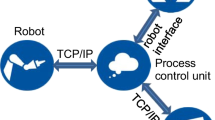Abstract
This study deals with the development of a new hammering tool called an “air-chipper”. A hammering tool is a typical deburring tool which is conventionally used to debur cast workpieces. Although the air-chipper is an effective tool, there are problems concerning durability and deburring quality. Surplus energy from the hammering motion is transferred to the damper rubber and causes deterioration of the rubber. This leads to breakage of the chisel holder for the air-chipper due to the high velocity contact with the stopper. In addition, the difficulty of directly measuring the chisel motion causes uncertainty of the deburring quality. Thus, improvement of the air-chipper was intended to solve the above problems by introducing an air damper. The air damper softens the impact force and absorbs the surplus energy of the chisel. Furthermore, it is possible to diagnose the deburring quality by measuring the inner pressure of the air damper. As a result, the air-chipper installed in a deburring robot system provides effective performance in combination with the image processing device.












Similar content being viewed by others
References
Asakawa N, Itoh K, Takeuchi Y (1998) Automatic deburring with industrial robot (removal of projection on a convex sculptured surface). J Jpn Soc Precis Eng 64(5):773–778
Yang BH, Asada H (1992) Hybrid linguistic/numerical control of deburring robots based on human skills. In: Proc IEEE ICRA, Nice, France pp 1467–1474
Yamaguchi M (1991) Feed rate control of deburring robot system. J Robot Soc Jpn 9(3):349–353
Seliger G, Hsieh LH, Spur G (1991) Sensor-aided programming and movement adaptation for robot-guided deburring of casting. Ann CIRP 40:487–490
Matsuo I, Okada M (1997) Highly accurate deburring with sensor-based robot. J Robot Soc Jpn 15(6):893–900
Nakata S, Sugita S, Goto M, Sato T, Aono T (1988) Deburring works under control of force sensor. Toyoda Koki Technical Review 29(1):13–18
Koyama T (1992) Developing vision sensing method in robot applied systems. In: The 18th seminar on science and technology, pp 161–174
Onoue M, Sonoda K (1990) Image processing technology, handbook for automation and systematization of inspection. Fuji Techno Systems, pp 236–237
Acknowledgement
The authors deeply appreciate the researchers at Toyoda Machine Works, Ltd. for their earnest collaboration with the study.
Author information
Authors and Affiliations
Corresponding author
Rights and permissions
About this article
Cite this article
Sugita, S., Takeuchi, Y. Automation of casting products finishing works by a robot—development of a hammering tool and its compensation function. Int J Adv Manuf Technol 23, 651–657 (2004). https://doi.org/10.1007/s00170-002-1457-1
Received:
Accepted:
Published:
Issue Date:
DOI: https://doi.org/10.1007/s00170-002-1457-1




